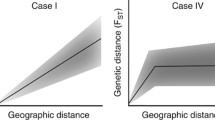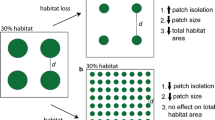Abstract
Compared with populations near the core of aspecies' range, edge populations tend to becharacterized by low density and high temporalvariation. Based on empirical studiesquantifying this pattern, we show thateffective population size (N e)could be 2 to 30 times greater near the coreof the species' range than near the edge ofthe range. Hence, the rate of genetic driftmay be 2 to 30 times greater near the edge ofthe range. Despite these strong spatialpatterns in N e, empirical findingsindicate that peripheral populations sometimeshave less but sometimes have more geneticdiversity than core populations. Our analysisindicates that this variation can be explainedby uncertainty in spatial patterns ofmigration rates. Nevertheless, our analysis:(1) provides a framework or null hypothesis forempirically assessing how spatial patterns ofmigration or selection influence large-scalespatial patterns of genetic diversity, (2)highlights the potential importance ofcontemporary processes, such as spatialpatterns in N e (cf. historicalphenomena, such as range expansion) in thedevelopment and maintenance of large-scalespatial patterns in genetic diversity, and (3) provides new context for understanding the conservation value and vulnerability of peripheralpopulations. The conservation ofecological/evolutionary processes requiresunderstanding large scale spatial patterns ofdemographic and genetic processes such as thatdescribed here.
Similar content being viewed by others
References
Allendorf FW, Bayles D, Bottom DL, Currens KP Frissell CA, Hankin D, Lichatowich JA, Nehlson W, Trotter PC, Williams TH (1997) Prioritizing Pacific salmon stocks for conservation. Conserv. Biol., 11, 140–152.
Bart J, Hofschen M, Peterjohn BG (1995) Reliability of the breeding bird survey: effects of restricting surveys to roads. Auk, 112, 758–761.
Bellemin J, Adest G, Gorman GC (1978) Genetic uniformity in northern populations of Thamnopsis sirtalis (Serpentes: Colubridae). Copeia, 1978, 150–151.
Betancourt JL, Schuster WS, Mitton JB, Anderson RS (1991) Fossil and genetic history of a pinyon pine (Pinus edulis) isolate. Ecology 72, 1685–1697.
Brown JH (1984) On the relationship between abundance and distribution of species. Am. Nat., 124, 255–279.
Caughley G, Grice D, Barker R, Brown B (1988) The edge of the range. J. Anim. Ecol., 57, 771–785.
Channell R, Lomolino MV (2000) Dynamic biogeography and conservation of endangered species. Nature, 403, 84–86.
Crow JF, Kimura M (1970) An Introduction to Population Genetics Theory. Harper and Row, New York.
Curnutt JL, Pimm SL, Maurer BA (1996) Population variability of sparrows in space and time. Oikos, 76, 131–144.
Cwynar LC, MacDonald GM (1987) Geographic variation in lodgepole pine in relation to population history. Am. Nat., 129, 463–469.
Descimon H, Napolitano M (1993) Enzyme polymorphism, wing pattern variability, and geographic isolation in an endangered butterfly species. Biol. Conserv., 66, 117–123.
Erb J, Stenseth NC, Boyce MS (2000) Geographic variation in population cycles of Canadian muskrats (Ondatra zibethicus). Can. J. Zool., 78, 1009–1016.
Frankham R, Ralls K (1998) Inbreeding leads to extinction. Nature, 392, 441–442.
Futuyma DJ (1986) Evolutionary Biology, 2nd edn. Sinauer, Sunderland, MA.
Gockel J, Kennington WJ, Hoffman A, Goldstein DB, Partridge L (2001) Nonclinality of molecular variation implicates selection in maintaining a morphological cline of Drosophila melanogaster. Genetics, 158, 319–323.
Griffith B, Scott JM, Carpenter JW, Reed C (1989) Translocation as a species conservation tool: status and strategy. Science, 245, 477–480.
Gyllenberg M, Hanski I (1992) Single-species metapopulation dynamics: A structured model. Theoretical Population Biology, 42, 35–61.
Hanski I, Gilpin ME, editors (1997) Metapopulation Biology. Academic Press, New York.
Hengeveld R (1990) Dynamic Biogeography. Cambridge University Press, Cambridge.
Hengeveld R, Haeck J (1982) The distribution of abundance. I. Measurements. J. Biogeogr., 9, 303–316.
Highton R, Webster TP (1976) Geographic protein variation and divergence in populations of the salamander Plethodon cinerus. Evol., 30, 33–45.
Hoffmann AA, Blows MW (1994) Species borders: ecological and evolutionary perspectives. Trends Ecol. and Evol., 9, 223–227.
Hoffmann AA, Parson PA (1991) Evolutionary Genetics and Environmental Stress. Oxford University Press, Oxford, UK.
Holt, RD (1985) Population dynamics in two-patch environments: some anomalous consequences of an optimal habitat distribution. Theor. Pop. Biol., 28, 181–208.
Holt, RD (1987) Population dynamics and evolutionary processes: The manifold roles of habitat selection. Evol. Ecol., 1 331–347.
Jain SK, Rai KN, Singh RS (1981) Population biology of Avena XI. Variation in peripheral isolates of A. barbata. Genetica, 56, 213–215.
Kendall WS (1992) Fractal scaling in the geographic distribution of populations. Ecol. Model., 64, 65–69.
Lande R (1991) Population dynamics and extinction in heterogeneous environments: the northern spotted owl. In: Bird population studies. Relevance to conservation and management (eds. Perrins CM, Lebreton J-D, Hirons GJM), pp. 566–580. Oxford University Press, Oxford.
Lande R (1992) Neutral theory of quantitative genetic variance in an island model with local extinction and colonization. Evolution, 46, 381–389.
Lande R (1995) Mutation and conservation. Conserv. Biol., 9, 782–791.
Lawton JH (1993) Range, population abundance and conservation. Trends in Ecol. Evol., 8, 409–413.
Lawton JH (1995) Population dynamic principles. In: Extinction Rates (eds. Lawton JH, May RM), pp. 147–163. Oxford University Press, Oxford.
Lawton JH, Nee S, Letcher AJ, Harvey PH (1994) Animal distributions: patterns and processes. In: Large Scale Ecology and Conservation Biology (eds. Edwards PJ, May RM, Webb, NR), pp. 41–58. Blackwell, Oxford.
Lesica P, Allendorf FW (1995) When are peripheral populations valuable for conservation? Conserv. Biol., 9, 753–760.
Linder ET, Villard M-A, Maurer BA, Schmidt EV (2000) Geographic range structure in North American landbirds: variation with migratory strategy, trophic level, and breeding habitat. Ecography, 23, 678–686.
Lomolino MV, Channel R (1995) Splendid isolation: Pattern of geographic range collapse in endangered mammals. J. Mamm., 76, 335–347.
Lynch M (1996) A quantitative-genetic perspective on conservation issues. In: Conservation Genetics: Case Histories from Nature (eds. Avise JC, Hamrock JL), pp. 471–501. Chapman & Hall, New York.
Mace G, Lande R (1991) Assessing extinction threats: Towards a reevaluation of IUCN threatened species categories. Conserv. Biol., 5, 148–157.
Maurer BA, Villard MA (1994) Geographic variation in abundance of North American birds. Res. Explor., 10, 306–317.
Meffert, LM (1999) How speciation experiments relate to conservation biology. Bioscience, 49, 701–711.
Merila J, Björklund M, Baker A (1996) Genetic population structure and gradual northward decline of genetic variability in the greenfinch (Carduelis chloris). Evol., 50, 2548–2557.
Montgomery ME, Woodworth LM, Nurthen RK, Gilligan DM, Briscoe DA, Frankham R (2000) Relationships between population size and loss of genetic diversity: comparisons of experimental results with theoretical predictions. Conserv. Genet., 1, 33–43.
Nunney L (2000). The limits to knowledge in conservation genetics: the value of effective population size. Evol. Biol., 32, 179–194.
Nunney L, Elam DR (1994) Estimating the effective population size of conserved populations. Conserv. Biol., 8, 175–184.
Pullium HR (1988) Sources, sinks, and population regulation. Am. Nat., 132, 652–661.
Pearl M (1992) Conservation of Asian primates: aspects of genetics and behavioral ecology that predict vulnerability. In: Conservation Biology: The Theory and Practice of Nature Conservation Preservation and Management (eds. Fielder PL, Jain SK), pp. 297–320. Chapman & Hall, New York.
Ranta E, Kaitala V, Lindstrom J, Helle E (1997) The Moran effect and synchrony in population dynamics. Oikos, 78, 136–142.
Sauer JR, Hines JE, Thomas I, Fallon J, Gough G (2000) The North American Breeding Bird Survey, results and analysis 1966-1999, version 98.1 (http://www.mbrpwrc. usgs.gov/bbs/bbs.html), Patuxent Wildlife Research Center, Laurel, Maryland, USA.
Saccheri I, Kuussaari M, Kankare M, Vikman P. Fortelius W, Hanski I (1998) Inbreeding and extinction in a butterfly metapopulation. Nature, 392, 491–494.
Sage RD, Wolff JO (1986) Pleistocene glaciations, fluctuating ranges, and low genetic diversity in a large mammal (Ovis dalli). Evol., 40, 1092–1093.
Schnabel A, Hamrick JL (1990) Organization of genetic diversity within and among populations of Gleditsia triacanthos (Leguminossae). Amer. J. Bot., 77, 1060–1069.
Scudder GGE (1989) The adaptive significance of Marginal Populations: A general perspective. In: Proceedings of the National Workshop on Effects of Habitat Alternation on Salmonid Stocks (eds. Levings CD, Holtby LB, Henderson MA), pp. 180–185. Can. Spec. Publ. Fish. Aquat. Sci., 105.
Stenseth NC, Chan K-S, Tong H, Boonstra R, Boutin S, Krebs CJ, Post E, O'Donoghue m, Yoccoz NG, Forchhammer MC, Hurrell JW (1999) Common dynamic structure of canada lynx populations within three climatic regions. Science, 285, 1071–1074.
Stevens G (1992) Spilling over the competitive limits to species coexistence. In: Systematics, Ecology, and the Biodiversity Crisis (ed. Edlridge N), pp. 40–58. Columbia University Press, New York.
Strange RM, Burr BM (1998) Intraspecific phylogeography of North American highland fishes: A test of the Pleistocene vicariance hypothesis. Evol., 51, 885–897.
Stewart CN, Excoffier L (1996) Assessing population genetic structure and variability with RAPD data: Application to Vaccinium macrocarpon (American cranberry). J. Evol. Biol., 9, 153–171.
Taylor LR (1986) Synoptic dynamics, migration and the Rothamsted insect survey. J. Anim. Ecol., 55, 1–38.
Tigerstedt PMA (1973) Studies on isozyme variation in marginal and central populations of Picea abies. Hereditas, 75, 47–60.
Templeton AR (1998) Nest clade analyses of phylogeographic data: testing hypotheses about gene flow and population history. Mol. Ecol., 7, 381–397.
Templeton AR, Routman E, Phillips C (1995) Seperating population structure from population history: a cladistic analysis of the geographical distribution of mitochondrial DNA haplotypes in the Tiger Salamander, Ambystoma tigrinum. Genetics, 140, 767–782.
Turchin P, Hanski I (1997) An empirically based model for latitudinal gradient in vole population dynamics. Am. Nat., 149, 842–874.
Vaisanen RA, Lehvaslaiho H (1984) Absence of genetic polymorphism in a northern population of house sparrow, Passer domesticus. Heredita, 100, 161–162.
Vucetich JA, Waite TA (1998) The number of censuses required for demographic estimation of effective population size. Conserv. Biol., 12, 1023–1030.
Vucetich JA, Waite TA (2000) Is one-migrant-per-generation suffi-cient for the genetic management of fluctuating populations? Animal Conserv., 3, 261–266.
Vucetich JA, Waite TA, Nunney L (1997) Fluctuating population size and the ratio of effective size to census size (Ne/N). Evol., 51, 2017–2021.
Vucetich LM, Vucetich JA, Waite TA, Peterson RO (in review) Genetic diversity and fitness in unmanipulated, natural populations of deer mice (Peromyscus maniculatus). Ecol. Applications.
Wolf CM, Griffith B, Reed C, Temple SA (1996) Avian and mammalian translocations: update and reanalysis of 1987 survey data. Conserv. Biol., 10, 1142–1153.
Wright S (1931) Evolution in Mendelian populations. Genetics, 16, 97–159.
Author information
Authors and Affiliations
Corresponding author
Rights and permissions
About this article
Cite this article
Vucetich, J.A., Waite, T.A. Spatial patterns of demography and genetic processes across the species' range: Null hypotheses for landscape conservation genetics. Conservation Genetics 4, 639–645 (2003). https://doi.org/10.1023/A:1025671831349
Issue Date:
DOI: https://doi.org/10.1023/A:1025671831349




